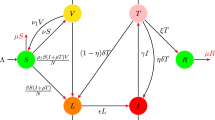Abstract
In this article, we propose a new mathematical model for tuberculosis considering the infectivity of both smear-positive and smear-negative individuals, searching for an efficient control strategy that may be followed to curtail the disease. We have employed different treatment regimens in various stages of tuberculosis infection. The fundamental epidemic threshold quantity \(R_0\) is inspected by the next-generation matrix method. The forward normalized sensitivity indices of the model parameters connected with \(R_0\) are computed to scale their impacts on the basic reproduction number. An optimal control problem is constructed considering three different treatment regimens in different possible stages of TB, and the control problem is solved analytically. The simulation results suggest that the combined implementation of all the controls optimally is the best policy to minimize the tuberculosis prevalence with the least interventions implementations costs.










Similar content being viewed by others
Availability of data and material
Not applicable
References
S. Khajanchi, D.K. Das, T.K. Kar, Physica A 497, 52 (2018)
Z. Feng, C. Castillo-Chavez, A.F. Capurro, Theor. Popul. Biol. 57, 235 (2000)
S. Mushayabasa, C.P. Bhunu, J. Biol. Phys. 39, 723 (2013)
D.K. Das, S. Khajanchi, T.K. Kar, Appl. Math. Comput. 366, 124732 (2020)
D.K. Das, T.K. Kar, J. Math. Anal. Appl. 492, 124407 (2020)
S. Pandey, V.K. Chadha, R. Laxminarayan, N. Arinaminpathy, Int. J. Tuberc. Lung Dis. 21, 366 (2017)
D.K. Das, S. Khajanchi, T.K. Kar, Chaos Solitons Fractals 130, 109450 (2020)
S. Athithan, M. Ghosh, Int. J. Dyn. Cont. 1, 223 (2013)
D. Okuonghae, A. Korobeinikov, Math. Modell. Nat. Phenom. 2, 113 (2007)
R.M. Des Prez, C. Muschenheim, J. Chronic Dis. 15, 599 (1962)
H.W. Kim, J.S. Kim, Tuberc. Respiratory Dis. 81, 6 (2018)
C.P. Bhunu, W. Garira, Z. Mukandavire, M. Zimba, Bull. Math. Biol. 70, 1163 (2008)
P. Desikan, Ind. J. Med. Res. 137, 442 (2013)
L.S.G. Linguissi, C.J. Vouvoungui, P. Poulain, G.B. Essassa, S. Kwedi, F. Ntoumi, B.M.C. Res, Notes 8, 804 (2015)
E. Hernandez-Garduno, V. Cook, D. Kunimoto, R.K. Elwood, W.A. Black, J.M. FitzGerald, Thorax 59, 286 (2004)
D.K. Das, T.K. Kar, Chaos Solitons Fractals 146, 110879 (2021)
A.K. Dutt, W.W. Stead, Semin. Respir. Infect. 9, 113 (1994)
R. Colebunders, I. Bastian, Int. J. Tuberc. Lung Dis. 4, 97 (2000)
L.C. Campos, M.V.V. Rocha, D.M.C. Willers, D.R. Silva, PloS One 11, e0147933 (2016)
T.K. Kar, S. Jana, Commun. Nonlinear Sci. Numer. Simul. 18, 2868 (2013)
T.K. Kar, S. Jana, BioSystems 111, 37 (2013)
G. Birkoff, G.C. Rota, Ordinary Differential Equations Ginn. Wiley, Boston (1982)
P. Van den Driessche, J. Watmough, Math. Biosci. 180, 29 (2002)
G. Zaman, Y.H. Kang, I.H. Jung, BioSystems 93, 240 (2008)
H.R. Joshi, Optim. Con. Appl. Methods 23, 199 (2002)
A. Khatua, T.K. Kar, S.K. Nandi, S. Jana, Y. Kang, Energ. Ecol. Environ. 5, 389 (2020)
A. Khatua, T.K. Kar, Eur. Phys. J. Plus 135, 1 (2020)
D.K. Das, A. Khatua, T.K. Kar, S. Jana, Appl. Math. Comput. 404, 126207 (2021)
W.H. Fleming, R.W. Rishel, Deterministic and Stochastic Optimal Control (Sringer-Verlag, New York, 1975)
D.L. Lukes, Differential Equations: Classical to Controlled (Academic Press, New York, 1982)
L.S. Pontryagin, V.G. Boltyanskii, R.V. Gamkrelidze, E.F. Mishchenko, The Maximum Principle, The Mathematical Theory of Optimal Processes (Wiley, New York, 1962)
N. Chitnis, J.M. Hyman, J.M. Cushing, Bull. Math. Biol. 70, 1272 (2008)
S. Lenhart, J.T. Workman, Optimal Control Applied to Biological Models, Mathematical and Computational Biology Series (Chapman & Hall/CRC, Boca Raton, 2007)
T.A. Yıldız, E. Karaoğlu, Nonlinear Dyn. 97, 2643 (2019)
Acknowledgements
The research of A. Khatua is financially supported by Department of Science and Technology-INSPIRE, Government of India (No. DST/INSPIRE Fellowship/2016/IF160667, dated: September 21, 2016). We are also grateful to the anonymous reviewers and the Editor-in-Chief for their valuable comments which have helped us a lot to improve the quality and the presentation of the manuscript significantly.
Funding
The research of A. Khatua is financially supported by Department of Science and Technology-INSPIRE, Government of India (No. DST/INSPIRE Fellowship/2016/IF160667, dated: 21st September, 2016).
Author information
Authors and Affiliations
Corresponding author
Ethics declarations
Conflict of interest
The authors declare that there is no conflict of interest.
Code availability
Not applicable.
Rights and permissions
About this article
Cite this article
Khatua, A., Das, D.K. & Kar, T.K. Optimal control strategy for adherence to different treatment regimen in various stages of tuberculosis infection. Eur. Phys. J. Plus 136, 801 (2021). https://doi.org/10.1140/epjp/s13360-021-01811-3
Received:
Accepted:
Published:
DOI: https://doi.org/10.1140/epjp/s13360-021-01811-3




